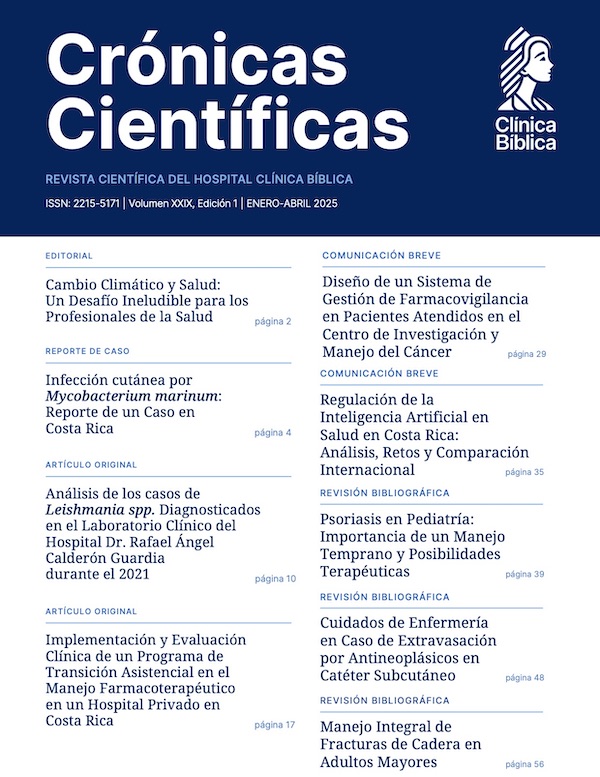- Visto: 688
Revisión Bibliográfica
Resultados a nivel de población con un enfoque en dos etapas para el cribado y diagnóstico de diabetes gestacional
DOI: https://doi.org/10.55139/NVGM2365
APA (7ª edición)
Borbón, D. M. F., Ramírez, F., Irias Casisi, S. I. (2017). Resultados a nivel de población con un enfoque en dos etapas para el cribado y diagnóstico de diabetes gestacional. Crónicas científicas, 6(6), 6-13. https://doi.org/10.55139/NVGM2365
Vancouver
Borbón DMF, Ramírez F, Irias Casisi SI. Resultados a nivel de población con un enfoque en dos etapas para el cribado y diagnóstico de diabetes gestacional. Cron cient. 12 de abril de 2017;6(6):6-13.
Dra. María Fernanda Borbón
Médico General
Miembro del Colegio de Médicos y Cirujanos de Costa Rica.
Costa Rica.
Fátima Ramírez
Interno Universitario UCIMED
Estudiante de Medicina, Universidad de Ciencias Médicas, UCIMED.
San José, Costa Rica.
Sebastián Irias Casisi
Interno Universitario UCIMED
Estudiante de Medicina, Universidad de Ciencias Médicas, UCIMED.
San José, Costa Rica.
Resumen
Examinar los resultados asociados con los umbrales de glucosa alternativos en un enfoque de 2 pasos para el cribado y el diagnóstico de la diabetes mellitus gestacional (GDM).
Métodos: Se estudiaron 178 527 embarazos entre 2008 y 2012 en Alberta, Canadá. Se categorizaron retrospectivamente como anestesia normal (n = 144 191), normal (GGTT) (n = 21 248); anormal en los umbrales de glucosa sugeridos por la Asociación Internacional de Diabetes y el Grupo de Embarazo (IADPSG) (HAPO 1.75, n = 4 308), anomalía de los umbrales de glucosa asociados con una proporción de 2.0 de anestesia en el estudio de Hiperglucemia y Adversidad de Parto Adverso (HAPO). Este último grupo que habría sido tratado para GDM basado en el cuidado habitual. Se dividió además en aquellos con 1 (HAPO 2-1, n = 5 528) o 2 o más valores de glucosa anormales (HAPO 2-2, n = 3 252). Los principales resultados fueron grandes para la edad gestacional (LGA), trabajo inducido y tasas de cesárea.
Resultados: Los LGA índices fueron 8.2%, 10.5%, 14.2%, 11.8% y 16.5% entre los grupos normales 50 g, normal 75 g OGTT, HAPO 1.75, HAPO 2-1 y HAPO 2-2 respectivamente. La inducción de cabecera y los porcentajes de cesárea fueron de 29.6% y 36.2% en IADPSG, 38.2% y 36.8% en el grupo HAPO 2-1, y 42.3% y 41.1% en los grupos HAPO 2-2, respectivamente. El peso materno excesivo (≥ 91 kg) fue asociado con un mayor riesgo para todos los resultados. Asimismo, hablaremos de metabolismo de carbohidratos, repercusiones de la hiperglicemia materno-fetal, además de posibles complicaciones.
Abordaremos también el diagnóstico de diabetes gestacional, así como conoceremos el manejo de una paciente que ya era diabética antes del embarazo o a la que se le diagnostica durante el embarazo.
Conclusiones: El enfoque de 2 pasos identifica eficazmente los embarazos con bajo riesgo de resultados adversos. Cualquier intolerancia a la glucosa aumenta el riesgo de resultados adversos y los embarazos con valores de glucosa anormales más altos (2 o más) siguen siendo los de mayor riesgo. Se necesitan más investigaciones para determinar si los umbrales glicémicos para el diagnóstico GDM deben incorporar información sobre el peso materno.
Palabras claves
Diabetes gestacional, HAPO: estudio de Hiperglicemia y Resultado Adverso del embarazo, OGTT: prueba oral de tolerancia a la glucosa, IADPSG: Asociación Internacional de los Grupos de Estudio de Diabetes y Embarazo.
Abstract
Objectives: To examine outcomes associated with alternative glucose thresholds in a 2-step approach for screening and diagnosing gestational diabetes mellitus (GDM).
Methods: We studied 178,527 pregnancies between 2008 and 2012 in Alberta, Canada. They were categorized retrospectively as normal 50 g screen (n = 144,191); normal 75g oral glucose tolerance test (OGTT) (n = 21,248); abnormal at glucose thresholds suggested by the International Association of Diabetes and Pregnancy Group (IADPSG) (HAPO 1.75, n = 4308); abnormal at glucose thresholds associated with an odds ratio of 2.0 for adverse events in the (HAPO) study. This latter group, which would have been treated for GDM based on customary care, was further divided into those with 1 (HAPO 2-1, n = 5528) or 2 or more abnormal glucose values (HAPO 2-2, n = 3252). Main outcomes were large for gestational age (LGA), induced labor and Cesarean-section rates.
Results: LGA rates were 8.2%, 10.5%, 14.2%, 11.8% and 16.5% among normal 50g, normal 75g OGTT, HAPO 1.75, HAPO 2-1, and HAPO 2-2 groups, respectively. Labor induction and caesarean-section rates were 29.6% and 36.2% in the ADPSG, 38.2% and 36.8% in the HAPO 2-1 group, and 42.3% and 41.1% in the HAPO 2-2 groups, respectively. Excessive maternal weight (≥ 91 kg) was associated with a higher risk for all adverse outcomes.
Conclusions: The 2-step approach effective identifies pregnancies at low risk for adverse outcomes. Labelling influences induction practice. Any glucose intolerance increases risk for adverse outcomes, and pregnancies with highest (2 or higher) abnormal glucose values remain at greatest risk. Further research is needed to determine whether glycemic thresholds for GDM diagnosis should incorporate information about maternal weight.
Bibliografía
Adam, K.P., Camastra, S., Ferrannini, E., Mari, A., Nannipieri, M., Natali, A. et al. (2013). Early metabolic markers of the development of dysglycemia and type 2 diabetes and their physiological significance. Diabetes. 62, 1730–7.
Aittasalo, M., Kinnunen, T.I., Luoto, R.M., Mansikkamaki, K., Ojala, K., Toropainen, E. et al. (2010). Prevention of gestational diabetes: design of a cluster-randomized controlled trial and one-year follow-up. BMC Pregnancy Childbirth.10, 39.
An, J., Bain, J.R., Lien, L.F., Muehlbauer, M.J., Newgard, C.B., Stevens, R.D. et al. (2009). A branched-chain amino acid-related metabolic signature that differentiates obese and lean humans and contributes to insulin resistance. Cell Metab. 9, 311–26.
Begum, J., Rani, P.R. (2016). Screening and diagnosis of gestational diabetes mellitus, where do we stand. J. Clin. Diagn. Res. 10 QE01–QE04. Recuperado de http://dx.doi.org/10.7860/JCDR/2016/17588.7689
Bellamy, L., Casas, J.P., Hingorani, A.D., Williams, D. (2009). Type 2 diabetes mellitus after gestational diabetes: a systematic review and meta-analysis. Lancet. 373, 1773–9.
Bibik-Malinowska, K., Dudzik, D., Kozlowska, G., Skotnicki, M., Zarzycki, W., Zorawski, M. et al. (2014). Metabolic fingerprint of gestational diabetes mellitus. J Proteome. 103, 57–71.
Brady, L.M., Gower, B.A., Lovegrove, J.A., Lovegrove, S.S., Williams, C.M. (2004). Revised QUICKI provides a strong surrogate estimate of insulin sensitivity when compared with the minimal model. Int J Obes Relat Metab Disord. 28, 222–7.
Burnett, R.W., D'Orazio, P., Fogh-Andersen, N., Kulpmann, W.R., Kuwa, K., Larsson, L. et al. (2001). IFCC recommendation on reporting results for blood glucose. Clin Chim Acta. 307, 205–9.
Charles, M.A., Hillier, T.A., Mullen, J.A., Pedula, K.L., Pettitt, D.J., Schmidt, M.M. (2007). Childhood metabolic imprinting: the ongoing effects of maternal hyperglycemia. Diabetes Care. 30, 2287–92.
Cheng, S., Larson, M.G., McCabe, E., Rhee, E.P., Vasan, R.S., Wang, T.J. et al. (2011). Metabolite profiles and the risk of developing diabetes. Nat Med. 17, 448–53.
Cho, N.H. (2013). Gestational diabetes mellitus-challenges in research and management. Diabetes Res. Clin. Pract. 99, 237–239. Recuperado de http://dx.doi.org/10.1016/j.diabres.2013.02.007
Connelly, P.W., Hanley, A.J., Qi, Y., Retnakaran, R., Sermer, M., Zinman, B. (2010). Glucose intolerance pregnancy and postpartum risk of metabolic syndrome in young women. J Clin Endocrinol Metab. 95, 670–7.
Dabelea, D., D’Agostino, Jr. R.B., Lamichhane, A.P., Liese, A.D., Mayer-Davis, E.J., Vehik, K.S. et al. (2008). Association of exposure to maternal diabetes and obesity with type 2 diabetes in youth: the SEARCH Case Control Study. Diabetes Care. 31, 1422–6.
Denis, M., Enquobahrie, D.A., Gelaye, B., Ressom, H.W., Tadesse, M.G., Williams, M.A. (2015). Maternal early pregnancy serum metabolites and risk of gestational diabetes mellitus. J Clin Endocrinol Metab. 100, 4348–56.
Ferrara, A. (2007). Increasing prevalence of gestational diabetes mellitus: a public health perspective. Diabetes Care. 30 S141–S146. Recuperado de http://dx.doi.org/10.2337/dc07-s206
Hosker, J.P., Matthews, D.R., Naylor, B.A., Rudenski, A.S., Treacher, D.F., Turner, R.C. (1985). Homeostasis model assessment: insulin resistance and beta-cell function from fasting plasma glucose and insulin concentrations in man. Diabetologia. 28, 412–9.
International Diabetes Federation (2015). IDF Diabetes Atlas. (7th. ed.). Recuperado de http://dx.doi.org/10.1289/image.ehp.v119.i03
Jovanovic, L., Pettitt, D.J. (2001). Gestational diabetes mellitus. JAMA. 286, 2516–2518. Recuperado de http://dx.doi.org/10.1373/clinchem.2013.203331.
Lind, T., Phillips, P.R. (1991). Influence of pregnancy on the 75-g OGTT. A prospective multicenter study. The Diabetic Pregnancy Study Group of the European Association for the Study of Diabetes. Diabetes. 40 (Suppl. 2), 8–13.
Newgard, C.B. (2012). Interplay between lipids and branched-chain amino acids in development of insulin resistance. Cell Metab. 15, 606–14.
APA (7ª edición)
Borbón, D. M. F., Ramírez, F., Irias Casisi, S. I. (2017). Resultados a nivel de población con un enfoque en dos etapas para el cribado y diagnóstico de diabetes gestacional. Crónicas científicas, 6(6), 6-13. https://doi.org/10.55139/NVGM2365
Vancouver
Borbón DMF, Ramírez F, Irias Casisi SI. Resultados a nivel de población con un enfoque en dos etapas para el cribado y diagnóstico de diabetes gestacional. Cron cient. 12 de abril de 2017;6(6):6-13.
Esta obra está bajo una licencia internacional Creative Commons: Atribución-NoComercial-CompartirIgual 4.0 Internacional (CC BY-NC-SA 4.0)

Realizar búsqueda
Última Edición
Ediciones






